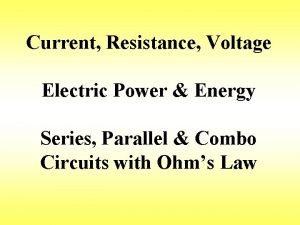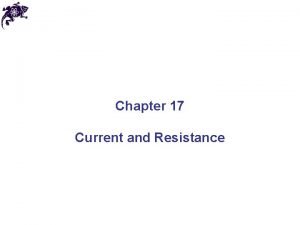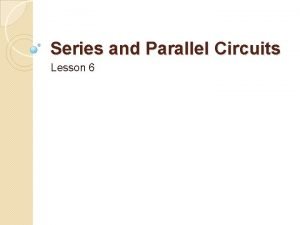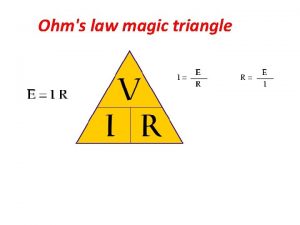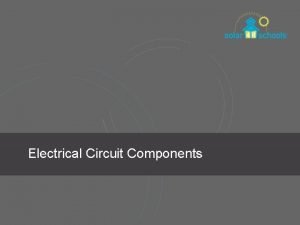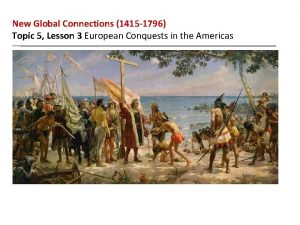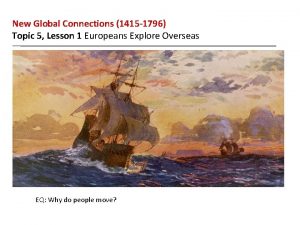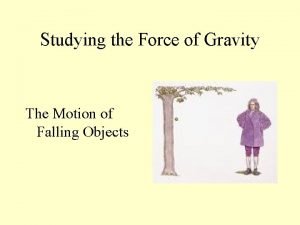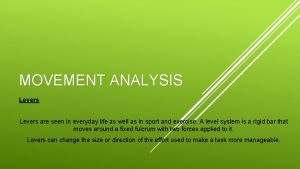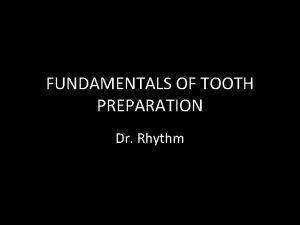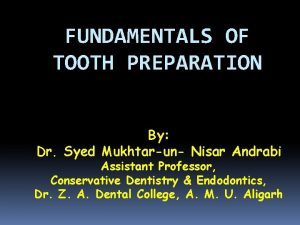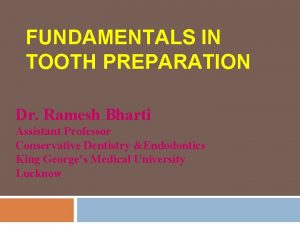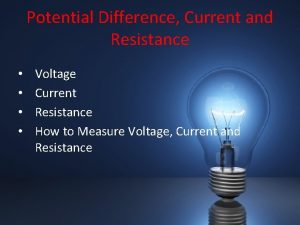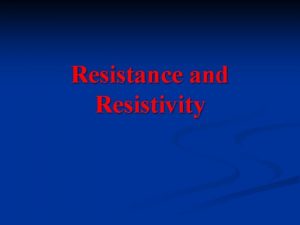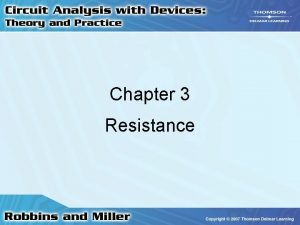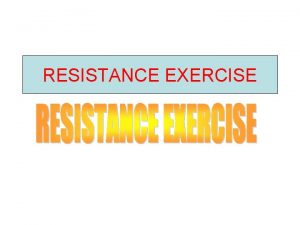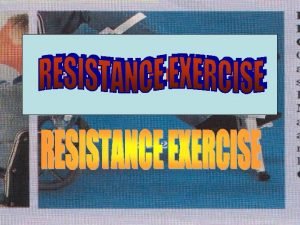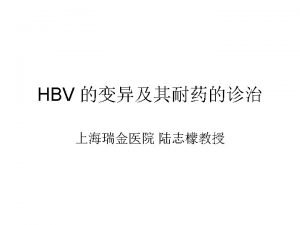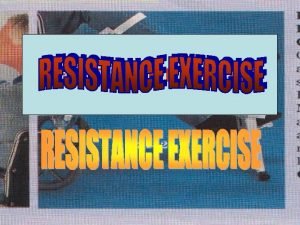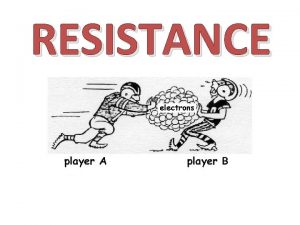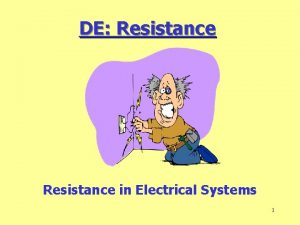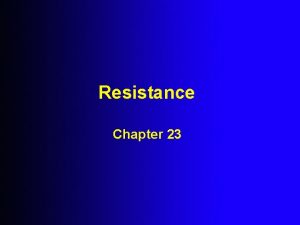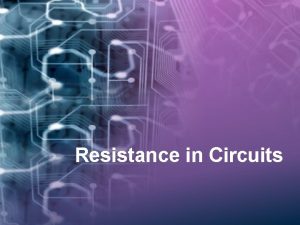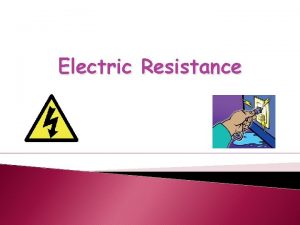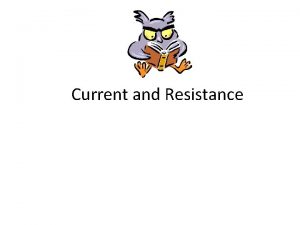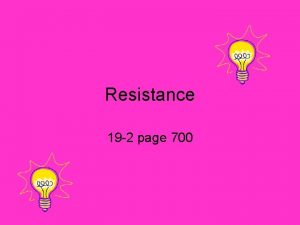Current and Resistance 1082008 New Topic Current and














































- Slides: 46

Current and Resistance 10/8/2008

New Topic: Current and Resistance

Physical Resistors

What Happens? “+” REMEMBER, THE ELECTRONS “+” ARE ACTUALLY MOVING THE OTHER WAY! - “+”

What’s Moving?

What is making the charged move? ? Battery

KEEP IN MIND A wire is a conductor We will assume that the conductor is essentially an equi-potential ◦ It really isn’t. Electrons are moving in a conductor if a current is flowing. ◦ This means that there must be an electric field in the conductor. ◦ This implies a difference in potential since E=DV/d ◦ We assume that the difference in potential is small and that it can often be neglected. ◦ In this chapter, we will consider this difference and what causes it.

DEFINITION Current is the motion of POSITIVE CHARGE through a circuit. Physically, it is electrons that move but … Conducting material DQ, Dt

Conducting material DQ, Dt

UNITS A current of one coulomb per second is defined as ONE AMPERE.

A charged belt, 30 cm wide, travels at 40 m/s between a source of charge and a sphere. The belt carries charge into the sphere at a rate corresponding to 100 µA. Compute the surface charge density on the belt. [8. 33 e-06] C/m 2

Comment on Current Flow

Question …. . A small sphere that carries a charge q is whirled in a circle at the end of an insulating string. The angular frequency of rotation is ω. What average current does this rotating charge represent?

Part II

Calendar Today we continue on Resistance and Resistors. EXAM #2 is NEXT FRIDAY – the 17 th of October Covers Potential through Resistance Quiz Grades are being re-normalized. Next topic will be electric circuits

An electric current is given by the expression I(t) = 100 sin(120πt), where I is in amperes and t is in seconds. What is the total charge carried by the current from t = 0 to t = (1/240) s?

ANOTHER DEFINITION

The figure represents a section of a circular conductor of non-uniform diameter carrying a current of 5. 00 A. The radius of cross section A 1 is 0. 400 cm. (a) What is the magnitude of the current density across A 1? (b) If the current density across A 2 is one-fourth the value across A 1, what is the radius of the conductor at A 2?

Ohm A particular object will resist the flow of current. It is found that for any conducting object, the current is proportional to the applied voltage. STATEMENT: DV=IR R is called the resistance of the object. An object that allows a current flow of one ampere when one volt is applied to it has a resistance of one OHM.

Graph

A DIODE Resistance Varies with Applied Voltage (actually with current)

Let’s look at the atomic level. . Conduction is via electrons. They are weak and small and don’t exercise much. Positive charge is big and strong and doesn’t intimidate easily. It’s an ugly situation … something like ……



III

Last time We defined ◦ Current (and Amperes) ◦ Current Density We defined Resistance and Ohm’s Law

Ohm’s Law

The Current Electrons are going the opposite way from the current. (WHY? ) They probably follow a path like … Average “drift” speed - vd IN OUT

Notation vd average drift velocity of the electron n number of electrons (mobile) per unit volume. Dt interval of time Dx average distance the electron moves in time Dt. Q total amount of CHARGE that goes through a surface of the conductor in time Dt.

The Diagram Often a Vector

We return to the diagram …. . Consider an electron. Assume that whenever it “bumps” into something it loses its momentum and comes to rest. It’s velocity therefore starts at zero, the electric field accelerates it until it has another debilitating collision with something else. During the time it accelerates, its velocity increases linearly. The average distance that the electron travels between collisions is called the “mean free path”.

Starting when the electron is at We showed two slides ago: rest: Let n= number of charge carriers per unit volume (mobile electrons) resistivity

Finally

Reference The average drift velocity of an electron is about 10 -4 m/s

Ponder How can a current go through a resistor and generate heat (Power) without decreasing the current itself?

Loses Energy Gets it back Exit

Conductivity In metals, the bigger the electric field at a point, the bigger the current density. s is the conductivity of the material. r=(1/s) is the resistivity of the material


A conductor of uniform radius 1. 20 cm carries a current of 3. 00 A produced by an electric field of 120 V/m. What is the resistivity of the material?

Range of r and s

Ye old RESISTANCE

REMEMBER THIS

Temperature Effect Dr DT

A closed circuit

Power

that’s it, Doc Next up: DC Electric Circuits fini
 Constant rate filtration example
Constant rate filtration example Force of air resistance
Force of air resistance Clincher sentence examples
Clincher sentence examples Broad and specific topic examples
Broad and specific topic examples How to find r total in a parallel circuit
How to find r total in a parallel circuit 17-1 current and resistance answers
17-1 current and resistance answers Lesson 6 current voltage and resistance in a circuit
Lesson 6 current voltage and resistance in a circuit Current potential difference and resistance
Current potential difference and resistance Young and freedman
Young and freedman Electricity triangle
Electricity triangle Resistance opposes the flow of charge
Resistance opposes the flow of charge Line current and phase current
Line current and phase current Phase to phase voltage
Phase to phase voltage Energy band diagram of pn junction diode
Energy band diagram of pn junction diode Ac theory 3 lesson 4
Ac theory 3 lesson 4 Drift vs diffusion current
Drift vs diffusion current What is diffusion current and drift current
What is diffusion current and drift current Balanced delta delta connection
Balanced delta delta connection Infineon
Infineon Diffusion current density
Diffusion current density New global connections
New global connections Topic 5 review questions new global connections answer key
Topic 5 review questions new global connections answer key The jfet always operates with
The jfet always operates with The shielded metal arc welding machines voltage output
The shielded metal arc welding machines voltage output Touch current vs leakage current
Touch current vs leakage current Non planar circuit
Non planar circuit New york pennsylvania new jersey delaware
New york pennsylvania new jersey delaware New oil and new wineskin
New oil and new wineskin Strengths of articles of confederation
Strengths of articles of confederation Marketing management
Marketing management New classical and new keynesian macroeconomics
New classical and new keynesian macroeconomics Chapter 16 toward a new heaven and a new earth
Chapter 16 toward a new heaven and a new earth Leanne keene french ambassador arrives from paris
Leanne keene french ambassador arrives from paris New classical and new keynesian macroeconomics
New classical and new keynesian macroeconomics Rules for speech punctuation
Rules for speech punctuation New hartford cinema
New hartford cinema New-old approach to creating new ventures
New-old approach to creating new ventures Njbta
Njbta Roosevelt taft and wilson venn diagram
Roosevelt taft and wilson venn diagram Why do objects fall at the same rate
Why do objects fall at the same rate Biotic potential
Biotic potential Effort arm and resistance arm
Effort arm and resistance arm Secondary resistance and retention form
Secondary resistance and retention form Secondary resistance and retention form
Secondary resistance and retention form Strongest enamel margin
Strongest enamel margin Biotic potential and environmental resistance
Biotic potential and environmental resistance How do machines make work easier
How do machines make work easier




